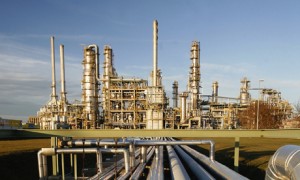 Both West Texas Intermediate and Brent crude benchmarks headed for their first weekly gain since September after the Peoples Bank of China cut interest rates for the first time in more than two years in an attempt to jump-start the cooling Asian economy. Natural gas fell as Arctic temperatures over the Midwest and Northeast began to fade, but more cold blasts lie ahead.
Both West Texas Intermediate and Brent crude benchmarks headed for their first weekly gain since September after the Peoples Bank of China cut interest rates for the first time in more than two years in an attempt to jump-start the cooling Asian economy. Natural gas fell as Arctic temperatures over the Midwest and Northeast began to fade, but more cold blasts lie ahead.
January US crude surged 1.69% to $77.13 per barrel by 13:50 GMT. Prices held in a daily range of $77.83-$75.62 a barrel. The contract rose 1.81% on Thursday to $75.85 and is up 1.8% so far this week.
Meanwhile on the ICE, Brent for delivery in the same month rose 1.85% to $80.80 a barrel, having shifted in a daily range between $81.61 and $79.07. The European crude benchmark gained 1.57% on Thursday to $79.33, settling at a premium of $3.48 to WTI. The gap widened to $3.67 on Friday.
The PBOC lowered its one-year deposit rate by 0.25% to 2.75%, while the one-year lending rate was cut by 0.4% to 5.6%. This was the first interest rate reduction since July 2012.
Carsten Fritsch, senior oil and commodities analyst at Commerzbank, said, cited by Reuters: “Commodity prices rise across the board, base metal prices in particular, but oil prices as well. Apparently there is hope that this step will lift commodities demand.”
The market also received a boost by growing division between investors’ expectations about the outcome of OPEC’s gathering next week. Venezuela reaffirmed its commitment to cut output, should the Organization of the Petroleum Exporting Countries decide to reduce its collective production, Foreign Minister Rafael Ramirez said.
Meanwhile, top two oil exporters Russia and Saudi Arabia agreed to cooperate on issues related to energy and oil markets. Russian Foreign Minister Sergei Lavrov said the two countries agreed that the oil market must be free of political and geopolitical influences.
According to a Bloomberg survey of analysts, half of the polled participants expect no change in the group’s production policy, while the rest project a reduction. Bank of America said that Saudi Arabia may prefer lower and volatile prices to force US shale producers out of the market.
“I think it will be very difficult for OPEC to agree a cut and announce a headline number,” said for CNBC Victor Shum, managing director of downstream energy consulting with IHS.
Bank of America forecast that the oil cartel may trim its collective production pace by no more than 500 000 bpd. However, many analysts also speculate that even if a production cut is voted, some members may not ensure compliance.
Economic data
The oil market was subjected to a slew of key economic data on Thursday. Manufacturing activity growth in China fell to the lowest in six months in November, according to a preliminary gauge, while business growth in the Eurozone stalled to a 16-month low.
Support, however, was drawn by better-than-expected economic figures from the US. Existing home sales rose by 1.5% in October to an annualized pace of 5.26 million, beating projections for a drop to 5.15 million from September’s upward-revised 5.18 million. This was the highest reading since September 2013.
Meanwhile, the Philadelphia Fed Manufacturing Index surged to 40.8 in November, the highest since March 2011, vastly exceeding expectations for a drop to 18.5 from 20.7 in October.
Natural gas
Natural gas fell on Friday as Arctic temperatures over the Midwest and Northeast began to fade, giving way to a warmer weekend. However, the energy source was still set for a sizable weekly gain, poised for more upside next week, amid forecasts for new cold blasts.
Natural gas for delivery in December fell by 3.52% to $4.331 per million British thermal units by 13:50 GMT. Prices held in a daily range between $4.532, the highest since November 10th, and $4.282 during the day. The energy source surged 2.7% on Thursday to $4.489 and is up 7.9% so far this week.
According to NatGasWeather.com, national natural gas demand over the next seven days will be moderate compared to normal, with a neutral to slightly-colder weather trend for the November 28 – December 4 period.
Arctic temperatures across the Midwest and Northeast have started to fade today, giving way to warmer-than-usual readings across the region during the weekend and significantly reducing heating demand. Highs over many southern and eastern regions are forecast to reach into the 60s and 70s through Sunday, including along the Northeast Coast.
However, warmer conditions will not last long, NatGasWeather.com reported, as a new colder system carrying rain and snow is expected to hit the north-central US early next week, pushing readings back below seasonal levels.
Moreover, a much more impressive system will arrive to the Northeast and Midwest around Thanksgiving Day, bringing additional snow and colder temperatures. It is expected to last through the following weekend, inducing very strong heating demand, and additional colder systems are likely to follow. Readings across the western US are expected to hold around seasonal, or slightly cooler levels.
Supplies
Adding to the overall bullish outlook, the Energy Information Administration reported on Thursday that US natural gas stockpiles fell by 17 billion cubic feet (bcf) in the seven days ended November 14th, the first withdrawal since March. This exceeded both analysts’ expectations for a decline of 6-12 billion cubic feet and the five-year average drop of 10 bcf.
Total gas held in US storage hub fell to 3.594 trillion cubic feet, widening the deficit to the five-year average of 3.838 trillion to 6.4% from 6.2% during the previous period. Last week’s inventory level was also 5.3% below the previous year’s 3.795 trillion during the comparable period.
Moreover, this week’s impressive Arctic blast is projected to lead to a significant draw for next week’s report, possibly exceeding the 100-bcf mark. The five-year average withdrawal for the week ending November 21st is 6 billion cubic feet.
Teri Viswanath, director of commodities strategy at BNP Paribas SA in New York, said for Bloomberg that early pipeline data suggest a draw of 150 billion cubic feet for next week’s report.





